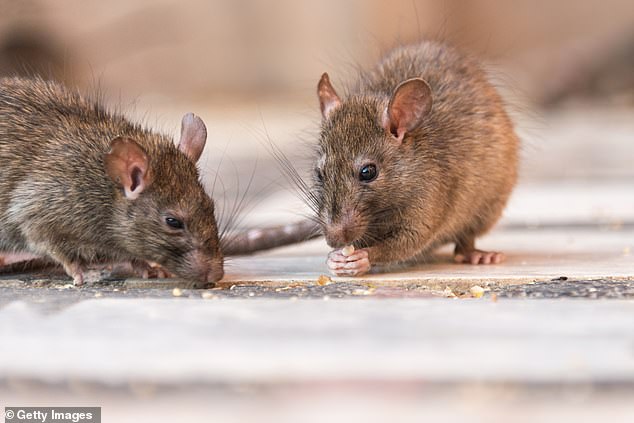Asian lungworm that spreads from rats to slugs to human BRAINS found in Atlanta as parasite takes foothold in Southeast US
A parasitic worm known to cause a potentially fatal brain infection when passed from rats to humans has taken hold in the southeastern US.
Researchers from Georgia, Texas and Mississippi confirmed that dead rats found in an Atlanta zoo were contaminated with parasitic substances A. cantonensisor lungworm, at least already in 2019.
The lungworm is native to Asia and the Pacific Islands, but is steadily migrating west thanks to international travel, global trade and a changing climate that makes new locations more livable.
Infections from rats to humans are rare, but not unheard of. Between 2011 and 2017, six human cases were discovered in several southern states and Hawaii, where the disease made headlines after 10 visitors spotted it in 2018 alone.
The 33 dead rats tested between 2019 and 2022 were collected at Zoo Atlanta in Georgia

Rats become infected when they eat snails and slugs that harbor the worm larvae. Once the rats ingest it, the parasite worms its way through their bodies and into the central nervous system. The parasite releases eggs into the rat’s pulmonary artery and then travels through the bloodstream, before being excreted in the rat’s feces.

Rat lungworm is a parasite that can be transmitted to humans if they eat raw slugs or snails. Seven of the 33 dead rats at the Atlanta Zoo had the parasite in their lung, brain and heart tissue
The parasite’s natural life cycle begins and ends with rodents becoming infected when they eat snails and slugs that harbor the worm larvae.
People are most at risk of becoming infected if they eat infected snails or vegetables covered in snail mucus, but they cannot spread it to another human.
Most people who become infected with lungworm will recover without medical treatment.
But if the worm infects a human and then travels to the brain, it can lead to a rare case of eosinophilic meningitis, caused by inflammation of the membranes that cover the brain and spinal cord.
From 2019 to 2022, veterinarians from the University of Georgia, Texas A&M University, Mississippi State University and Zoo Atlanta in Georgia’s capital conducted tests on 33 dead brown rats found on zoo grounds.
Specifically, they examined tissue from the brain, heart, liver, kidneys, lungs, spleens, skeletal muscle, skin, gastrointestinal tract, adrenal glands and gonads of the dead rats.
Seven of the rats had worms, or nematodes as researchers call them, in their hearts, pulmonary arteries and brain tissue.
Of those seven, four were confirmed to be infected with lungworm. The three remaining were not confirmed to have lungworm, but researchers noted that they had worms in their blood vessels consistent with A. cantonensis.
Lungworm had previously been discovered in rats in Florida and Alabama, leading researchers to believe that lungworm was likely present in Georgia long before the first dead rats were examined in 2019.
At least six cases of the parasite had also been found in humans over a six-year period in the Southeast.
The researchers said: ‘Discovery of native cases of A. cantonensis infection in permanent host rodents collected during 2019-2022 in the State of Georgia suggests that this zoonotic parasite was introduced and established in a new area of the southeastern United States .’
Their findings were published in the CDC’s journal Emerging Infectious Diseases.
Four confirmed infections with the brain-infecting parasite served as an alarm bell for epidemiologists who have been tracking the spread of diseases from their places of origin to remote areas such as the United States.
As the global climate continues to warm, more and more places will feel that the lungworm belongs in Southeast Asia, making more places like the southeastern US suitable habitat.
A prolonged warm season also means the parasite can flourish longer and infect more species.
Lungworm gets its name from the characteristic way it uses the rat host’s own respiratory system to grow.
The parasite’s life cycle begins when eggs are excreted in a rat’s feces and hatch into the environment in what researchers call first-stage larvae, or L1.
Snails and slugs then swallow the larvae in the environment as they feed. In the snail’s digestive system, the larvae enter the second phase of life. When it reaches the third stage of development, it has acquired the capacity to infect other hosts, including humans.
A mammal, such as the common brown rat found at Zoo Atlanta, eats that infected snail, and the third-stage larvae travel from the rat’s digestive tract to the lungs where eggs are released and circulate through the bloodstream.
People who eat the infected snails or slugs, often daringly, according to the CDC, are at greater risk of becoming infected, but they are not guaranteed to experience symptoms.
They may experience nausea and vomiting a few hours to a few days after eating an infected snail. There is no specific treatment for lungworm and it usually goes away on its own.
Neurological symptoms such as headache, stiff neck, tingling or tingling sensations in the extremities and sensitivity to light may follow.
Eosinophilic meningitis due to lungworm infection is rare approximately 3,000 documented cases worldwide since 1944. However, this could be an undercount as many cases may remain undiagnosed or untreated.
